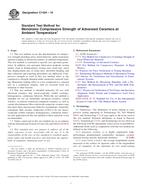Potřebujeme váš souhlas k využití jednotlivých dat, aby se vám mimo jiné mohly ukazovat informace týkající se vašich zájmů. Souhlas udělíte kliknutím na tlačítko „OK“.
ASTM C1424-10
Standard Test Method for Monotonic Compressive Strength of Advanced Ceramics at Ambient Temperature
Automaticky přeložený název:
Standardní zkušební metoda pro monotónní pevnost v pokročilých keramiky při pokojové teplotě
NORMA vydána dne 1.12.2010
Informace o normě:
Označení normy: ASTM C1424-10
Poznámka: NEPLATNÁ
Datum vydání normy: 1.12.2010
Kód zboží: NS-11194
Počet stran: 13
Přibližná hmotnost: 39 g (0.09 liber)
Země: Americká technická norma
Kategorie: Technické normy ASTM
Anotace textu normy ASTM C1424-10 :
Keywords:
advanced ceramic, compression test, compressive strength, Advanced ceramics, Compression testing--advanced ceramics, Geometric analysis, Monotonic compressive strength, Test specimen geometries, Uniaxial compression testing, ICS Number Code 81.060.30 (Advanced ceramics)
Doplňující informace
| Significance and Use | ||||||||||||||||||
|
This test method may be used for material development, material comparison, quality assurance, characterization, and design data generation. Generally, resistance to compression is the measure of the greatest strength of a monolithic advanced ceramic. Ideally, ceramics should be compressively stressed in use, although engineering applications may frequently introduce tensile stresses in the component. Nonetheless, compressive behavior is an important aspect of mechanical properties and performance. Although tensile strength distributions of ceramics are probabilistic and can be described by a weakest link failure theory, such descriptions have been shown to be inapplicable to compressive strength distributions in at least one study (1). However, the need to test a statistically significant number of compressive test specimens is not obviated. Therefore, a sufficient number of test specimens at each testing condition is required for statistical analysis and design. Compression tests provide information on the strength and deformation of materials under uniaxial compressive stresses. Uniform stress states are required to effectively evaluate any nonlinear stress-strain behavior which may develop as the result of cumulative damage processes (for example, microcracking) which may be influenced by testing mode, testing rate, processing or compositional effects, microstructure, or environmental influences. The results of compression tests of test specimens fabricated to standardized dimensions from a particular material or selected portions of a part, or both, may not totally represent the strength and deformation properties in the entire, full-size product or its in-service behavior in different environments. For quality control purposes, results derived from standardized compressive test specimens may be considered indicative of the response of the material from which they were taken for given primary processing conditions and post-processing heat treatments. cterization, and design data generation.Generally, resistance to compression is the measure of the greatest strength of a monolithic advanced ceramic. Ideally, ceramics should be compressively stressed in use, although engineering applications may frequently introduce tensile stresses in the component. Nonetheless, compressive behavior is an important aspect of mechanical properties and performance. Although tensile strength distributions of ceramics are probabilistic and can be described by a weakest link failure theory, such descriptions have been shown to be inapplicable to compressive strength distributions in at least one study (1).3 However, the need to test a statistically significant number of compressive test specimens is not obviated. Therefore, a sufficient number of test specimens at each testing condition is required for statistical analysis and design. Compression tests provide information on the strength and deformation of materials under uniaxial compressive stresses. Uniform stress states are required to effectively evaluate any nonlinear stress-strain behavior which may develop as the result of cumulative damage processes (for example, microcracking) which may be influenced by testing mode, testing rate, processing or compositional effects, microstructure, or environmental influences. The results of compression tests of test specimens fabricated to standardized dimensions from a particular material or selected portions of a part, or both, may not totally represent the strength and deformation properties in the entire, full-size product or its in-service behavior in different environments. For quality control purposes, results derived from standardized compressive test specimens may be considered indicative of the response of the material from which they were taken for given primary processing conditions and post-processing heat treatments. |
||||||||||||||||||
| 1. Scope | ||||||||||||||||||
|
1.1 This test method covers the determination of compressive strength including stress-strain behavior, under monotonic uniaxial loading of advanced ceramics at ambient temperature. This test method is restricted to specific test specimen geometries. In addition, test specimen fabrication methods, testing modes (load or displacement), testing rates (load rate, stress rate, displacement rate, or strain rate), allowable bending, and data collection and reporting procedures are addressed. Compressive strength as used in this test method refers to the compressive strength obtained under monotonic uniaxial loading. Monotonic loading refers to a test conducted at a constant rate in a continuous fashion, with no reversals from test initiation to final fracture. 1.2 This test method is intended primarily for use with advanced ceramics that macroscopically exhibit isotropic, homogeneous, continuous behavior. While this test method is intended for use on monolithic advanced ceramics, certain whisker- or particle-reinforced composite ceramics as well as certain discontinuous fiber-reinforced composite ceramics may also meet these macroscopic behavior assumptions. Generally, continuous fiber ceramic composites (CFCCs) do not macroscopically exhibit isotropic, homogeneous, continuous behavior and, application of this test method to these materials is not recommended. 1.3 Values expressed in this test method are in accordance with the International System of Units (SI) and . 1.4 This standard does not purport to address all of the safety concerns, if any, associated with its use. It is the responsibility of the user of this standard to establish appropriate safety and health practices and determine the applicability of regulatory limitations prior to use. |
||||||||||||||||||
| 2. Referenced Documents | ||||||||||||||||||
|




 Cookies
Cookies
